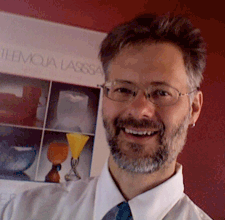Pilgrim Reindeer in Pisa, 1348
a free multimedia novel by
Thomas A. DuBois, University of Wisconsin-Madison
 |
Pilgrim Reindeer in Pisa, 1348 a free multimedia novel by Thomas A. DuBois, University of Wisconsin-Madison |
|
|
|
1. Part I Setting Out 9. The Church of the Holy Risti [August 11, 1347]
This chapter and the one that comes after it are important in that they mark the entry of Bávlos into a string of interactions that are going to continue all the way to Italy. Up till now, Bávlos has been dealing with the foreign in the person of a single interlocutor. From here on, however, Bávlos will meet with one after another person and have to interpret them both as individuals and as exemplars of their unfamiliar cultures. Such reflects the experience of pilgrims in the medieval era: in recognition of the holy purpose for their travel, they received permission to cross cultural boundaries as needed and confronted firsthand the diversity of languages and cultures that marked medieval Christendom. Bávlos is going to meet with many different people and cultures on his journey.
I also enjoyed depicting Pekka in his characteristic self-centeredness: his assumption that he is the leader simply because he comes from the southern culture, when in fact he has been utterly dependent on Bávlos for much of the journey. Now, when Pekka could at last return the favor to his companion and show Bávlos the world between Hämeenlinna and Turku, he proves too busy to bother. Perhaps Bávlos would have welcomed an opportunity to visit the priory which Pekka lives; perhaps he would have appreciated getting to meet some of the people he had apparently seen in his dream. But Pekka makes no such offer: now that they are close to home, he wants nothing more to do with his exotic companion. Sometimes travel is like that: one person does a great deal for a fellow traveller, perhaps even a complete stranger, while the latter does little in return. If you have ever been on one side or another of such a relationship, you know what I mean. If you do not recall such a situation and yet you have travelled, perhaps you were the recipient.
I also wanted to set up the notion of sculpture as an important recurrent topic in the novel. Bávlos has grown up in a culture where a sieidi sculpture acted as a major recipient of sacrifices and entreaties. So he might well be expecting a similar use of sculpture in the spiritual life of this new culture. Indeed, his expectations are met and even exceeded: here in Christian Hattula there are similarly important statues, but they are far more elaborate in terms of style and workmanship than what Bávlos knows from his Sámi experience. Sculptures of this sort recur at key moments throughout the novel, and form a recurrent theme in the work as a whole. Consider it an art historical foible on my part, but remember that the whole novel aims at explaining the details of a single Italian fresco.